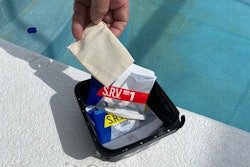
As automatic pool covers become more popular in some states, retailers are using peace of mind as their strongest selling point. With just the turn of a key, pool owners can shield their pools from the elements and effectively create a barrier between the water and their children.
"I don't think anything is a safer barrier on a pool than an automatic pool cover," says Bruce Holmes, CEO of Pools of Fun in Indianapolis. "These covers range from $6,000 to $95,000, but compared to an accident, that's nothing."
The layer of safety that automatic pool covers can provide is allowing some families to purchase pools while their children are still young, increasing business for the pool and spa industry.
"I think it's a tremendous boom for the pool business," says Lou Downes, president of Downes Swimming Pool Co., Arlington Heights, Ill. "I'm able to build a pool for a couple that's not going to wait for the kids to be 10 or 12 years old. They're doing it right away."
And once they have an automatic pool cover, homeowners are finding they don't require much care to work properly.
"One of the things dealers are concerned about is if these are hard to maintain," says Michael Shebek, president of Automatic Pool Covers in Fishers, Ind. "But that's not the case anymore. It hasn't been for years. These covers are much better than they were in the past."
Despite improvements to these types of covers, whether they close and open easily depends on if they are installed correctly and ultimately on how the homeowner has been trained to maintain and clean them.
"If you're going to install covers on pools you build, you should have enough integrity to discuss with the homeowner that it'll need maintenance," says Downes. "This is something that's not being talked about. Nobody likes surprises."
To minimize the number of service calls and headaches, builders, installers, retailers and techs have a responsibility to train pool cover owners to clean, maintain and winterize their products.
Auto Cleaning
Debris from sandset and concrete decks, trees, grass clippings and construction can often get into the tracks of an auto cover, making it operate improperly. That material can also collect in the housing with a similar effect.
"If you're bringing back sticks and things like that, you run the risk of debris building up in the housing quickly," says Shebek, who compares this debris buildup to leaves getting caught in a gutter. "It works the way it's supposed to if you keep debris off the cover."
Bird droppings and wind-borne pollution can also have a negative affect, Downes says.
Holmes recommends using a powerful leaf blower to get rid of debris or the film of dust that can accumulate if construction work is being done nearby.
Holmes also suggests using a brush to apply a cover cleaner to the auto cover once or twice a year. The homeowner should use an auto cover pump to keep the water off while brushing it, then hose it down.
Cleaners packaged and marketed for the industry are not necessarily the only options for cleaning, however. Jay Tucker, owner of Swim World Pools in Tennessee, recommends any citrus-based, non-abrasive, natural cleaner. Tim O'Neil, operations manager for Downes, says using Ivory soap flakes and water two times per year at a minimum will keep the cover looking new.
O'Neil stresses cleaning the mechanism vault, which often fills up with dirt and seeds, and the mechanism ends up sitting in mold. If the cover box floods as a result, electronic motors will start to corrode.
O'Neil adds that indoor pools with auto covers also need regular cleaning to remove the dissolved solids that accumulate on them.
Auto Chemistry
Unbalanced water chemistry and pool chemicals that get splashed about can also take their toll on an auto cover's longevity. Water with a high alkalinity will shrink the fabric and make it brittle, O'Neil says.
"If pool chemistry is kept within normal industry standards, it's no problem at all," he says.
According to Downes, homeowners must be careful as they apply chlorine to the water because the chemical will eventually wear out the side of the cover resting on the water. High chlorine levels will also create a gas that fades the underside. Holmes suggests the pool owner open the pool a couple hours a day to release the chemical gasses that have built up from the chlorine.
Air pollution can sometimes be a concern. "It's not a big issue, but a lot of times you have acid rains and so forth that can throw off chemicals in the pool if it's not covered," Holmes says. "If you have an auto cover, the cover actually catches it before it gets into the water and helps keep the water chemistry balanced."
Winterizing
If auto pool covers are properly winterized, they can last season after season, even in climates where snowfalls are dramatic and the temperature fluctuates over 100 degrees throughout the year.
Although some manufacturers' brochures say auto covers can be used as winter covers, many auto cover experts recommend against this because snow loads can rip them apart. Instead, the pool owner should thoroughly clean the cover before rolling it up into the cover vault. If the right chemicals are applied to the pool during the season, this treatment will prevent mildew and keep the cover in good condition.
Customers who do use the auto cover as a winter cover need to make sure that at least 65 to 75 percent of the cover sits on top of the water so that it is supported, Shebek says. If it rains or snows over an inch, Holmes suggests pumping it off. This is easier than other winterizing techniques, he says.
"Customers today want everything as user friendly and maintenance free as possible," Holmes says. "So if the customer doesn't have to deal much with the auto cover or solar blanket, they love it."
Opening a pool with an auto cover in the spring seems just as easy.
"The best thing to do when opening the cover is to tap the key, bump it a little, to break the seal," Shebek says. "It's been sitting there for four or five months and needs to be set free slowly."
Once it starts to move, the opening should go smoothly. Holmes then recommends a professional perform a routine maintenance on the cover, including cleaning the fabric and the cover box, checking the glides and the cover box and doing necessary repairs.
Increasing The Life Span
A well-prepared, well-educated pool owner can expand the lifespan of his or her auto cover by years, with a few replacements here and there.
Downes says customers can expect to replace the fabric between five and seven years after installation, depending on how many times the cover is opened and closed. Holmes warranties his vinyl-coated covers for seven years. And O'Neil places his trust in a wellmaintained mechanism.
"I would think a mechanism properly maintained should last for 20 years," he says. "Not flooded, but lubed and cleaned, it should last 20 years."
Many auto cover experts recommend the installer or a service tech come out to the home two or three times a year to clean, lubricate, adjust, inspect and replace damaged auto cover parts. This is also a perfect time to continue educating the pool owner.
"The best thing to do is any time the homeowner is out there, educate him on how the cover should look," Shebek says. "Communicating with the homeowner does wonders."
Checklist For Troubleshooting
Despite the pool owner's best attempts to keep the auto cover clean, sometimes professional service is necessary. Here is a checklist of troubleshooting tips for the tech responding to such calls:
- Make sure the mechanism is properly adjusted and lubricated so the cover does not come out of adjustment and run crookedly (like a garage door off of its tracks).
- Worn-out items: The leading-edge bar sliders and fabric at the end of the track are common culprits.
- Clean out the debris that has collected in the cover housing. This includes scooping out the leaves and other debris to help the cover run better.
- If water builds up on the cover, this places too much stress on the motor and the motor shaft may spin in a circle without moving the cover. This means more tension must be applied to the torque limiter.
- If one side of the pool cover comes back 2 to 3 inches ahead of the other side, adjust the ropes the appropriate number of inches and then reattach them.
— L.R.M.







































